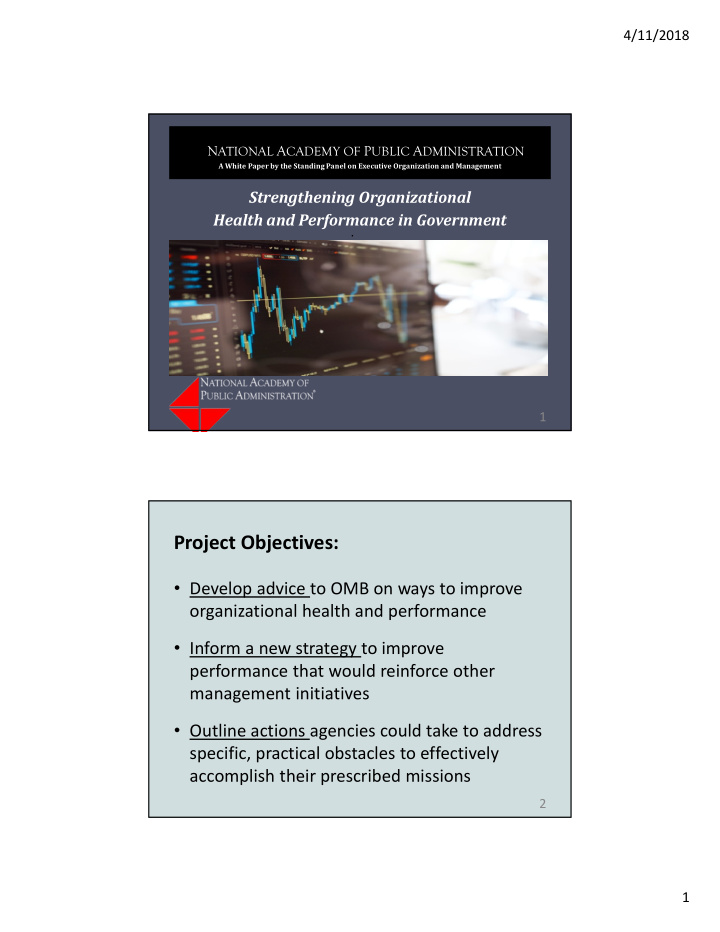



4/11/2018 N ATIONAL A CADEMY OF P UBLIC A DMINISTRATION A White Paper by the Standing Panel on Executive Organization and Management Strengthening Organizational Health and Performance in Government • 1 Project Objectives: • Develop advice to OMB on ways to improve organizational health and performance • Inform a new strategy to improve performance that would reinforce other management initiatives • Outline actions agencies could take to address specific, practical obstacles to effectively accomplish their prescribed missions 2 1
4/11/2018 The Study Panel of NAPA Fellows John Kamensky (Chair) Michael Maccoby Jonathan Breul Donald Moynihan Nani Coloretti Demetra Nightingale Doris Hausser Andrew Podger Judy England Joseph Steve Redburn Donald Kettl Prajapati Trivedi Bob Lavigna 3 Overview • Why now? • The current federal performance framework is incomplete • What we know about improving organizational health and performance • Private and public practices used to improve • Vision and behaviors to improve organizational health • Principles and elements of a new strategy • Recommended near-term actions 4 2
4/11/2018 Why a new strategy now? • Current performance framework mainly engages policy officials, senior managers • Granular data on organizational health and performance growing in volume • Supply of performance data higher, but use by front-line managers is not • Current framework is missing key elements 5 What would complete the government’s performance improvement framework? • Make sub-agency units the building blocks for improving performance • Link pursuit of performance with parallel pursuit of increased organizational health or capacity • Engage lower-level managers and their staffs in a collaborative effort to raise organizational performance • Help managers learn how to analyze data to guide their operations • Facilitate knowledge transfer and learning across organizational boundaries 6 3
4/11/2018 What we know • How can “organizational health” be defined? • What are characteristics of high performing organizations? • What contributes to better organizational health? • What strategies contribute to better organizational health? 7 Public and private sector examples • Private sector – Gartner benchmarking – IBM’s use of people analytics • Other countries – Australia – Canada – New Zealand • US federal agencies – Agriculture – Army – Labor Department 8 4
4/11/2018 The Federal government’s challenge . . . • Develop a vision of organizational health and continuing performance improvement • Establish principles and elements of a new strategy to improve organizational health and capacity to perform • Identify first steps to implement the new strategy • Continue to learn from experience and refine the strategy based on evidence. 9 Vision – Where We Want to Go Transform the federal government into an organization that: • learns from experience, • constructively engages employees at all levels in this shared enterprise, and • continually strives toward higher standards of excellence in achieving its many prescribed missions and policy objectives. 10 5
4/11/2018 Desired Behaviors – Senior Managers • Managers at all levels share commitment to, understand agency’s mission and objectives. • Senior managers act quickly on information about and ideas for improving performance received from program and front-line managers. • Senior managers track, report on, and reward actions taken to address obstacles to better performance identified by managers at all levels. 11 Desired Behaviors – Front-line Managers • Will have a clear understanding of how their work contributes to agency mission and strategic objectives • Are given analytic tools, training to manage using an emerging array of ‘big data’ • Understand need to build high-engagement work places, act on data to build engagement and assess progress • Are assessed (and assess own work) based on contribution to agency strategic objectives and priority goals • Are recognized and rewarded, not punished, for calling attention to, recommending actions to address obstacles to better performance 12 6
4/11/2018 Principles for a New Strategy • Apply new data analytics to target efforts to improve organizational capacity and health. • Extend the federal performance framework to reach program managers, frontline operating units, and mission support units. • Use metrics not as an accountability hammer but to foster continuous learning and improvement. 13 Three Elements of a New Strategy • Element 1. Help Agency Leaders and Managers Strengthen Organizational Units’ Organizational Health and Performance • Element 2. Develop a Learning-Based Approach to Improving Results • Element 3. Help Agency Leaders and Managers Employ the Power of Data Analytics to Manage 14 7
4/11/2018 Recommended Near-Term Actions - Caveats • Limits of current knowledge and the complexity of the task require modesty about how much can be achieved in the near term. • Near-term actions should aim to: – achieve near-term successes in addressing organizational conditions and factors inhibiting better performance; and – establish a government-wide learning process that would facilitate agency performance improvement strategies and inform future actions. 15 3 Sets of Near-Term Actions • Action 1: Use existing data to assess and diagnose the state of agency and unit-level organizational health and performance. • Action 2: Develop a learning-based approach to improve organizational capacity and performance; and • Action 3: Help managers make effective use of flood of new data relevant to their operations by giving them tools, skills to manage in new data-rich environment. 16 8
4/11/2018 Concluding Thoughts • Can be no blueprint for a fully developed strategy to improve government’s performance -- we are too ignorant and the task is too complex. • An odyssey, not a day trip: arc of history may bend toward better government but it is certainly long. • Success depends on our ability to learn from experience. 17 Sub-Elements of New Cross-Agency Priority Goal: 21st Century Workforce 18 9
Recommend
More recommend